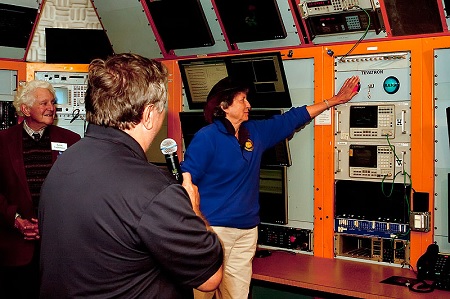Staff and Users Celebrated the Tevatron's Last Beam - September 30

From left: Leon Lederman, Nobel Laureate (1988 Physics) and former Director of Fermilab; Robert Mau, the former head of Fermilab Accelerator Operations; and Helen Edwards, the former head of the Accelerator Division, aborting colliding beams in the Tevatron for the last time. Photo: Marty Murphy, AD
Thousands of Fermilab staff members and scientific collaborators flooded Fermilab and watched remotely online from across the globe Friday to see the Tevatron power down one final time. Following the shutdown, everyone joined in to celebrate nearly three decades of scientific and technological achievements that have changed the way we understand the world.
"The Tevatron exceeded every expectation ever set for it," said Fermilab Director Pier Oddone, as the 40-minute shutdown procedure began. "As of this moment, the two detectors, CDF and DZero, have recorded nearly 12 inverse femtobarns of data. The collider has reached peak luminosities of 4 x 1032 per centimeter squared per second, producing several million collisions per second. These numbers were considered totally impossible by scientists and engineers back in the eighties when the machine first came online."
The Tevatron again and again did the impossible. It was the world's first superconducting synchrotron. It required the development of the world's most intense, consistent source of antiprotons. It eventually operated 300 times beyond its original design capabilities.
The creativity and tools needed for these achievements helped enable consumer products, such as MRI machines, and a globally competitive workforce that has gone on to help design the Large Hadron Collider and countless other physics experiments as well as improve industries as diverse as finance and manufacturing.
Shutting the Tevatron down Friday was a bittersweet time for employees and users, many of whom had spent most of their careers making the Tevatron one of the most productive sources of physics research in the world. CDF and DZero will continue to churn out analyses from Tevatron data at an average rate of one scientific paper a week for at least two more years.
"We will really miss the Tevatron but we have to move on and hopefully do something even better, contributing to pushing back the frontiers of science," said Roger Dixon, head of the Accelerator Division.
Fermilab plans to build upon the pioneering spirit that built the world's largest proton-antiproton accelerator in the middle of a prairie to now build the world's most powerful linear proton accelerator, Project X. This will enable Fermilab to lead in a new era of precision physics, producing the largest number of particles to optimize the study of the rarest particle interactions.
The myriad neutrino, muon and kaon experiments operating and planned are attracting young scientists from across the globe. They will face the challenge of topping the breadth of the Tevatron's scientific accomplishments.
The discovery of the tau neutrino by the Tevatron's fixed-target program has been one of the main achievements in neutrino physics worldwide.
"The Tevatron program has been remarkably successful; from the discovery of the top quark, to the precision measurement of the W boson mass, the observation of Bs mixing and the many limits set on potential new physics theories," said Rob Roser, co-spokesperson for CDF. "The Tevatron has changed the way the world views particle physics."
In the collider program, CDF and DZero improved our understanding of the building blocks in the Standard Model, the recipe for the matter that makes up everything we see and for how the rules of nature affect daily life. They observed the strongest evidence yet for an imbalance in matter and antimatter in particles. This imbalance tipped the cosmic scales in matter's favor. The discoveries made by CDF and DZero include the top quark and a whole new family of baryons.
The subsequent precision measurements of the top quark as well as those of the W boson mass have laid the groundwork for the search for the Higgs boson. Without the mass the Higgs bosons imparts to fundamental particles, the world as we know it would not exist. Because the Higgs lives for less than the blink of an eye, physicists at the Tevatron and LHC would not be able to hunt it down without the guiding measurements of the particles it decays into.
"To make discoveries you need to understand the Standard Model," said Dmitri Denisov, DZero co-spokesman. "To understand, you need to do calculations. And to do calculations, you need to be able to study particles to high precision. The data from the Tevatron enables us to excel at that."


